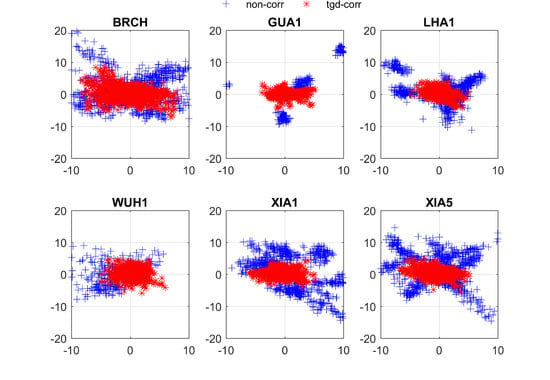BDS-3 Time Group Delay and Its Effect on Standard Point Positioning
Abstract
1. Introduction
2. Methodology
2.1. General Observation Model
2.2. Single-Frequency Users
2.3. Dual-Frequency Users
3. Experimental Data and Processing Strategies
4. Validation and Analysis
4.1. BDS-2
4.2. BDS-3
4.3. BDS2 + BDS-3
5. Conclusions
Author Contributions
Funding
Acknowledgments
Conflicts of Interest
References
- Lou, Y.; Liu, Y.; Shi, C.; Yao, X.; Zheng, F. Precise orbit determination of BeiDou constellation based on BETS and MGEX network. Sci. Rep. 2014, 4, 4692. [Google Scholar] [CrossRef] [PubMed]
- Yang, Y.; Xu, Y.; Li, J.; Yang, C. Progress and performance evaluation of BeiDou global navigation satellite system: Data analysis based on BDS-3 demonstration system. Sci. China Earth Sci. 2018, 6, 614–624. [Google Scholar] [CrossRef]
- Li, X.; Yuan, Y.; Zhu, Y.; Huang, J.; Wu, J.; Xiong, Y.; Zhang, X.; Li, X. Precise orbit determination for BDS3 experimental satellites using iGMAS and MGEX tracking networks. J. Geod. 2018, 93, 103–117. [Google Scholar] [CrossRef]
- Ge, Y.; Yang, X.; Qin, W.; Su, H.; Wu, M.; Wang, Y.; Wang, S. Time Transfer Analysis of GPS- and BDS-Precise Point Positioning Based on iGMAS Products. China Satell. Navig. Conf. 2018, 497, 519–530. [Google Scholar]
- Ge, Y.; Yang, X.; Qin, W.; Yang, H.; Guang, W.; Zhou, F.; Ouyang, M.; Wang, S. Mitigation of the multipath effect in BDS-based time transfer using a wave-absorbing shield. Adv. Space Res. 2018, 63, 2771–2783. [Google Scholar] [CrossRef]
- Chu, F.Y.; Yang, M. BeiDou System (BDS) Triple-Frequency Ambiguity Resolution without Code Measurements. Remote Sens. 2018, 10, 675. [Google Scholar] [CrossRef]
- Zhao, Q.; Guo, J.; Li, M.; Qu, L.; Hu, Z.; Shi, C.; Liu, J. Initial results of precise orbit and clock determination for COMPASS navigation satellite system. J. Geod. 2013, 87, 475–486. [Google Scholar] [CrossRef]
- Li, X.; Zhang, X.; Ren, X.; Fritsche, M.; Wickert, J.; Schuh, H. Precise positioning with current multi-constellation Global Navigation Satellite Systems: GPS, GLONASS, Galileo and BeiDou. Sci. Rep. 2015, 5, 8328. [Google Scholar] [CrossRef]
- Guo, F.; Li, X.; Zhang, X.; Wang, J. The contribution of Multi-GNSS Experiment (MGEX) to precise point positioning. Adv. Space Res. 2016, 59, 2714–2725. [Google Scholar] [CrossRef]
- Guo, F.; Zhang, X.; Wang, J. Timing group delay and differential code bias corrections for BeiDou positioning. J. Geod. 2015, 89, 427–445. [Google Scholar] [CrossRef]
- Zhang, X.; He, X. Performance analysis of triple-frequency ambiguity resolution with BeiDou observations. GPS Solut. 2015, 20, 269–281. [Google Scholar] [CrossRef]
- Manzino, A.M.; Dabove, P.; Gogoi, N. Assessment of positioning performances in Italy from GPS, BDS and GLONASS constellations. Geod. Geodyn. 2018, 9, 439–448. [Google Scholar] [CrossRef]
- Wanninger, L.; Beer, S. BeiDou satellite-induced code pseudorange variations: diagnosis and therapy. GPS Solut. 2015, 19, 639–648. [Google Scholar] [CrossRef]
- Mao, Y.; Wang, Q.; Hu, C.; He, Y. Accuracy Analysis of BDS-3 Experiment Satellite Broadcast Ephemeris. China Satell. Navig. Conf. 2018, 498, 341–354. [Google Scholar]
- Wu, Z.; Zhou, S.; Hu, X.; Liu, L.; Shuai, T.; Xie, Y.; Tang, C.; Pan, J.; Zhu, L.; Chang, Z. Performance of the BDS3 experimental satellite passive hydrogen maser. GPS Solut. 2018, 22. [Google Scholar] [CrossRef]
- Xu, X.; Li, M.; Li, W.; Liu, J. Performance Analysis of Beidou-2/Beidou-3e Combined Solution with Emphasis on Precise Orbit Determination and Precise Point Positioning. Sensors (Basel) 2018, 18, 135. [Google Scholar] [CrossRef] [PubMed]
- Zhao, Q.; Wang, C.; Guo, J.; Wang, B.; Liu, J. Precise orbit and clock determination for BeiDou-3 experimental satellites with yaw attitude analysis. GPS Solut. 2017, 22. [Google Scholar] [CrossRef]
- Zhou, R.; Hu, Z.; Zhao, Q.; Li, P.; Wang, W.; He, C.; Cai, C.; Pan, Z. Elevation-dependent pseudorange variation characteristics analysis for the new-generation BeiDou satellite navigation system. GPS Solut. 2018, 22. [Google Scholar] [CrossRef]
- Li, X.; Xie, W.; Huang, J.; Ma, T.; Zhang, X.; Yuan, Y. Estimation and analysis of differential code biases for BDS3/BDS2 using iGMAS and MGEX observations. J. Geod. 2018, 93, 419–435. [Google Scholar] [CrossRef]
- CSNO. BeiDou Navigation Satellite System Signal in Space Interface Control Document, Open Service Signal B3I (Version 1.0); China Satellite Navigation Office: Beijing, China, February 2018. [Google Scholar]
- CSNO. BeiDou Navigation Satellite System Signal in Space Interface Control Document, Open Service Signal B1C (Version 1.0); China Satellite Navigation Office: Beijing, China, December 2017. [Google Scholar]
- CSNO. BeiDou Navigation Satellite System Signal in Space Interface Control Document, Open Service Signal B2a (Version 1.0); China Satellite Navigation Office: Beijing, China, December 2017. [Google Scholar]
- Xie, X.; Fang, R.; Geng, T.; Wang, G.; Zhao, Q.; Liu, J. Characterization of GNSS Signals Tracked by the iGMAS Network Considering Recent BDS-3 Satellites. Remote Sens. 2018, 10, 1736. [Google Scholar] [CrossRef]
- Ye, F.; Yuan, Y.; Ou, J. Initial orbit determination of BDS-3 satellites based on new code signals. Geod. Geodyn. 2018, 9, 342–346. [Google Scholar] [CrossRef]
- Leick, A.; Rapoport, L.; Tatarnikov, D. GPS Satellite Surveying, Fourth Edition; Wiley: Hoboken, NJ, USA, 2015. [Google Scholar]
- Ge, Y.; Zhou, F.; Sun, B.; Wang, S.; Shi, B. The Impact of Satellite Time Group Delay and Inter-Frequency Differential Code Bias Corrections on Multi-GNSS Combined Positioning. Sensors (Basel) 2017, 17, 602. [Google Scholar] [CrossRef] [PubMed]
- CSNO. BeiDou Navigation Satellite System Signal in Space Interface Control Document-Open Service Signal, Version 2.0; China Satellite Navigation Office: Beijing, China, December 2013. [Google Scholar]
- Hernández-Pajares, M.; Juan, J.M.; Sanz, J.; Orus, R.; Garcia-Rigo, A.; Feltens, J.; Komjathy, A.; Schaer, S.C.; Krankowski, A. The IGS VTEC maps: A reliable source of ionospheric information since 1998. J. Geod. 2009, 83, 263–275. [Google Scholar] [CrossRef]
- CSNO. BeiDou Navigation Satellite System Signal in Space Interface Control Document-Open Service Signal B1I, Version 1.0; China Satellite Navigation Office: Beijing, China, December 2012. [Google Scholar]
- CSNO. BeiDou Navigation Satellite System Open Service Performance Standard, Version 2.0; China Satellite Navigation Office: Beijing, China, December 2018. [Google Scholar]
- Jiao, G.; Song, S.; Ge, Y.; Su, K.; Liu, Y. Assessment of BeiDou-3 and Multi-GNSS Precise Point Positioning Performance. Sensors 2019, 19, 2496. [Google Scholar] [CrossRef] [PubMed]
- Ferland, R.; Piraszewski, M. The IGS-combined station coordinates, earth rotation parameters and apparent geocenter. J. Geod. 2009, 83, 385–392. [Google Scholar] [CrossRef]
- Cai, H.; Chen, K.; Xu, T.; Chen, G. The iGMAS Combined Products and the Analysis of Their Consistency. In Proceedings of the China Satellite Navigation Conference (CSNC), Xi’an, China, 13–15 May 2015. [Google Scholar]





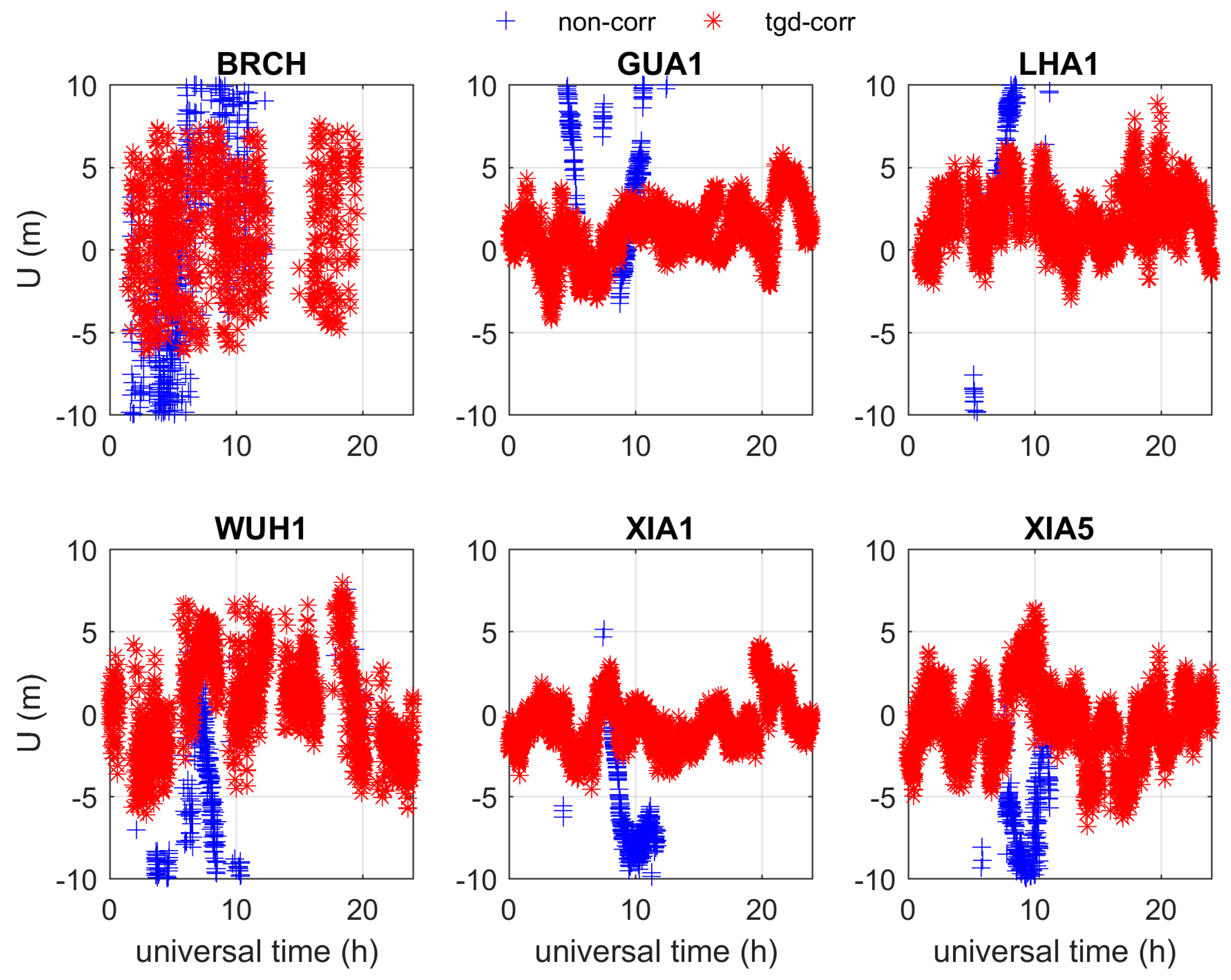
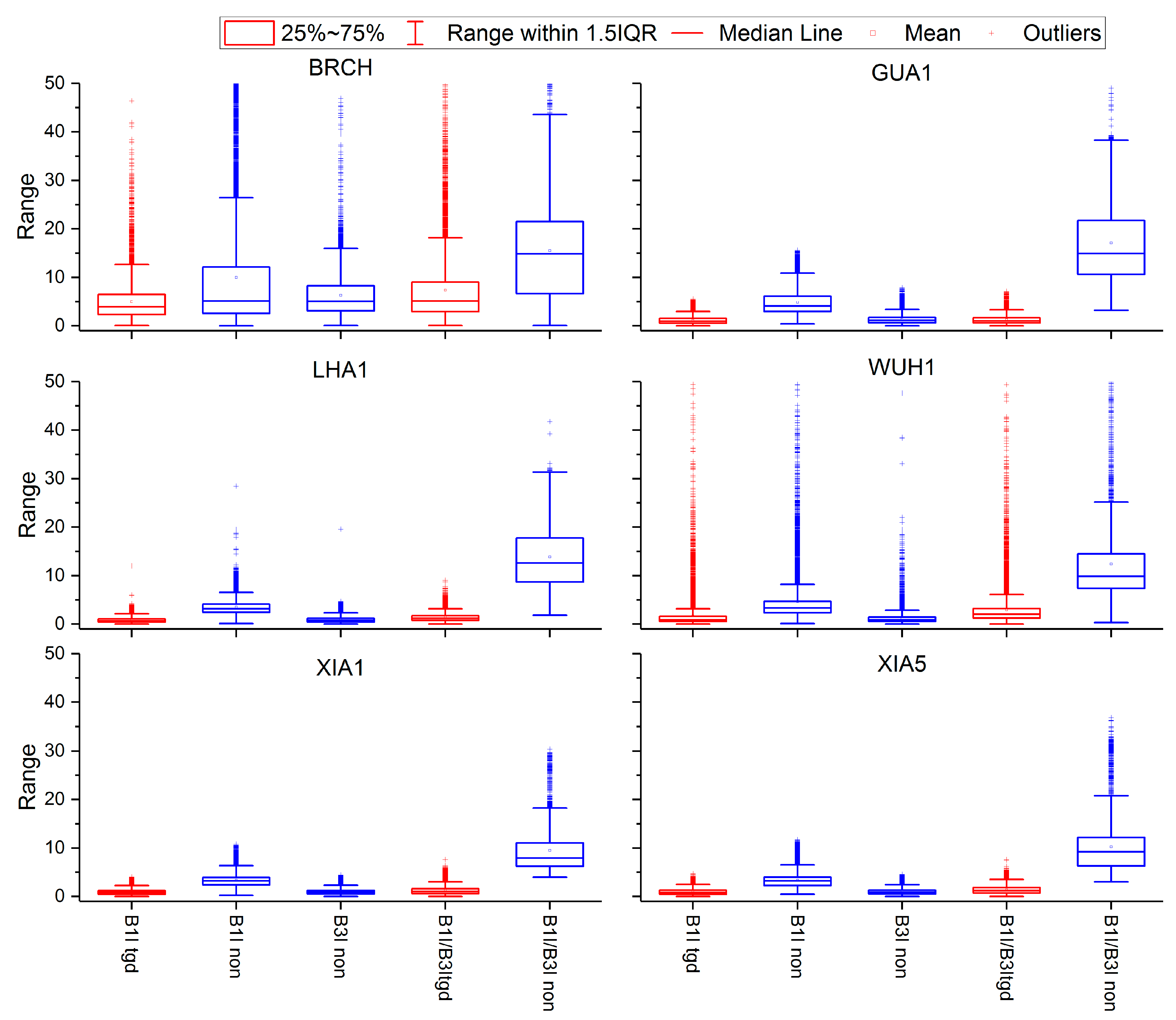
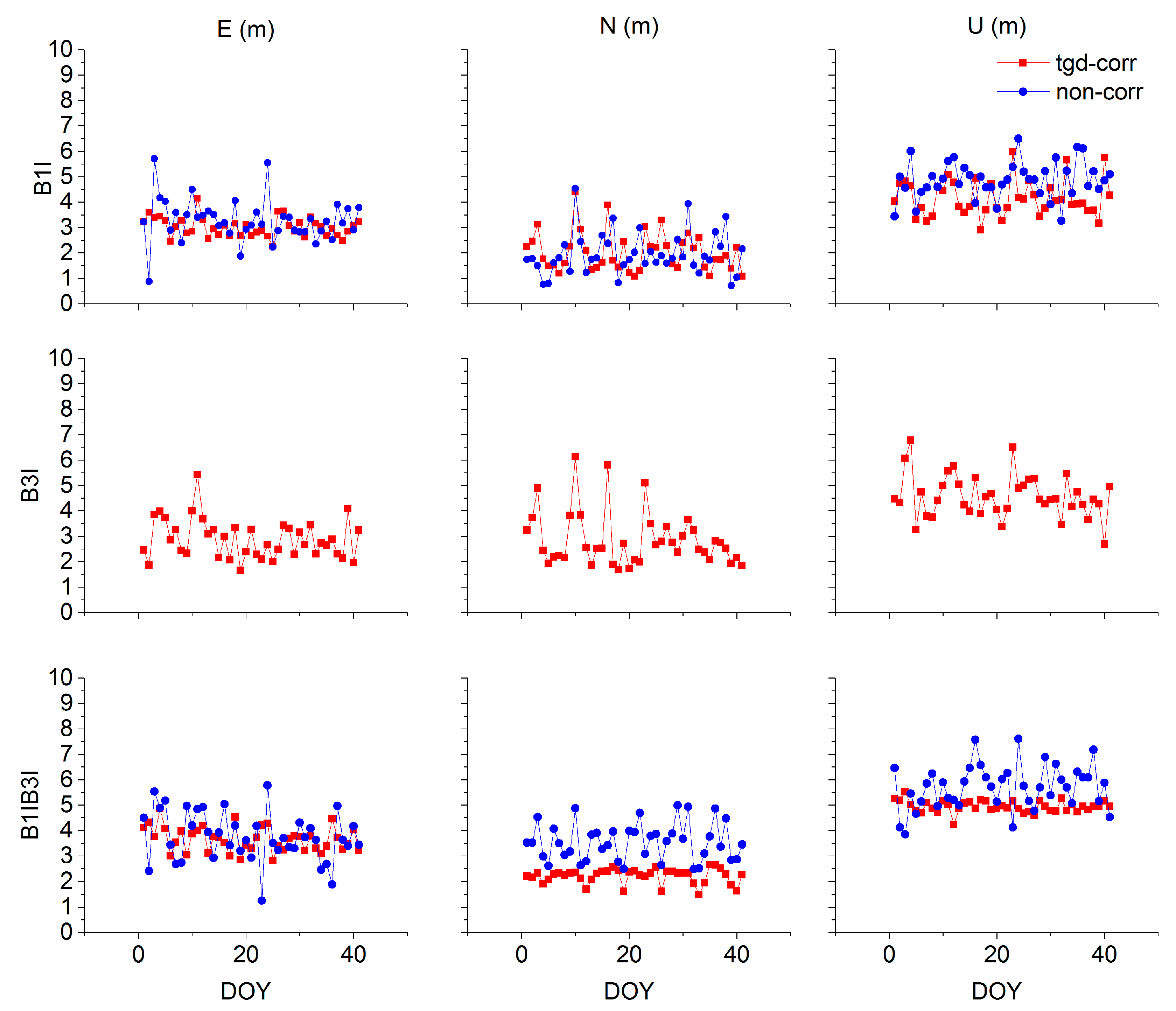



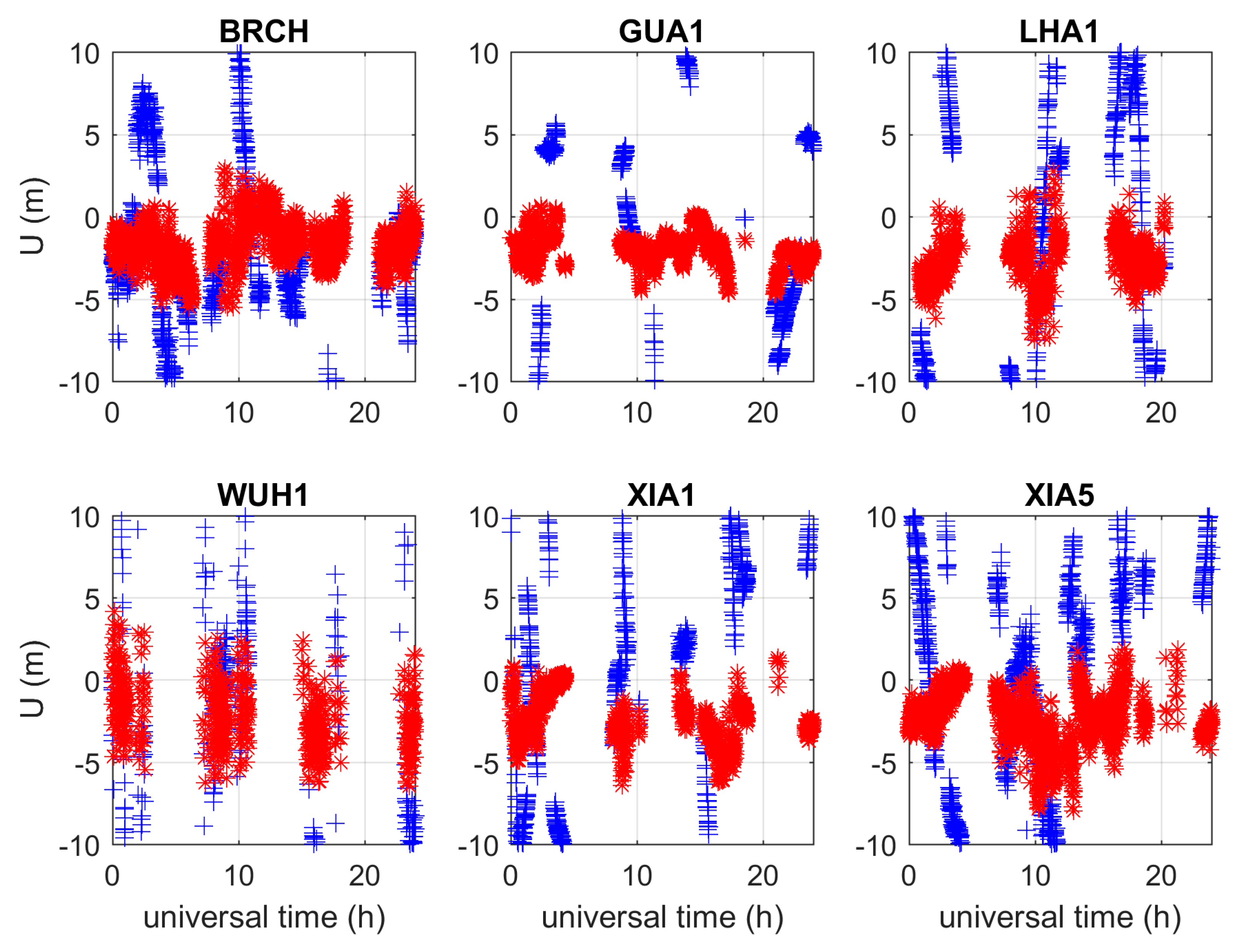



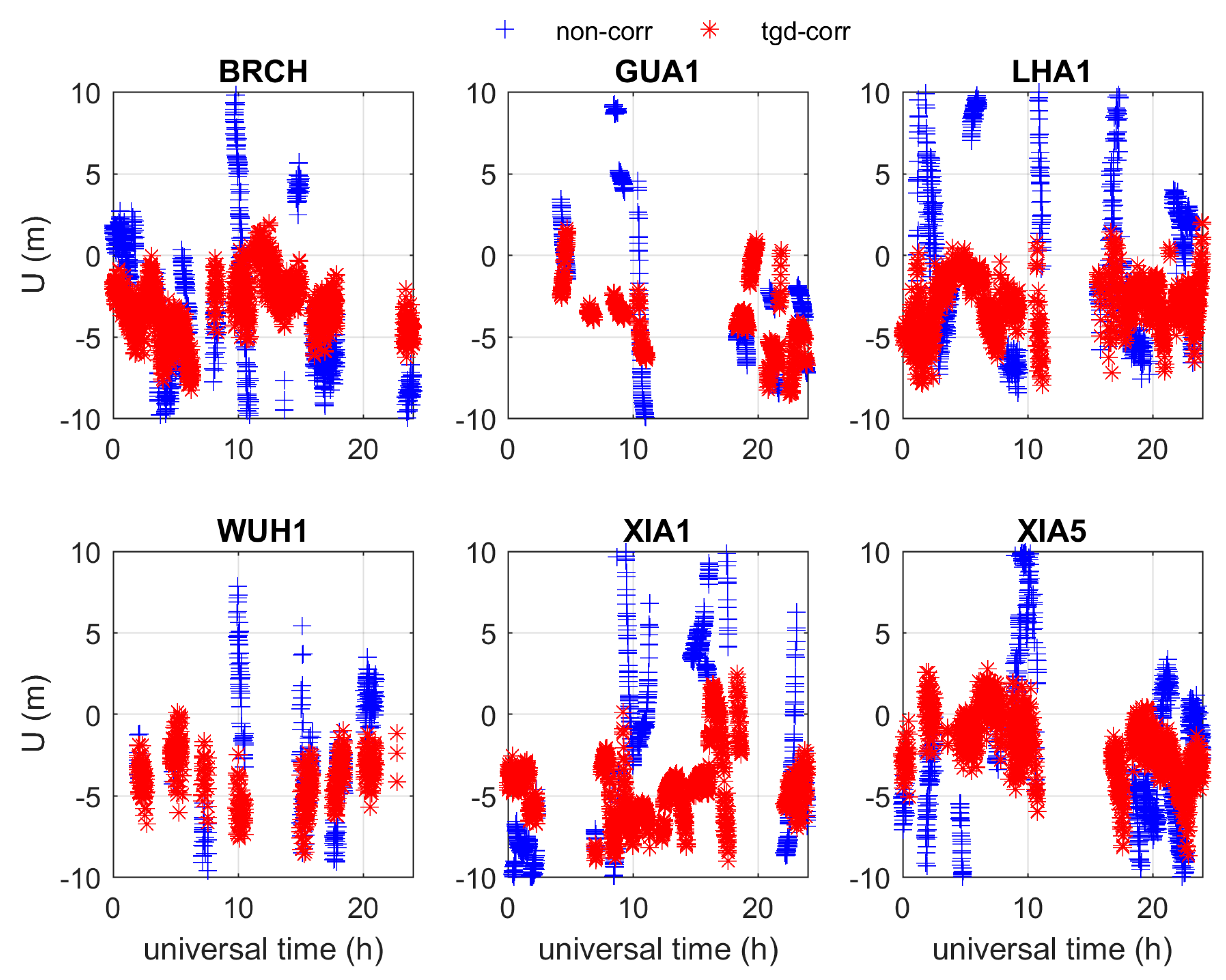
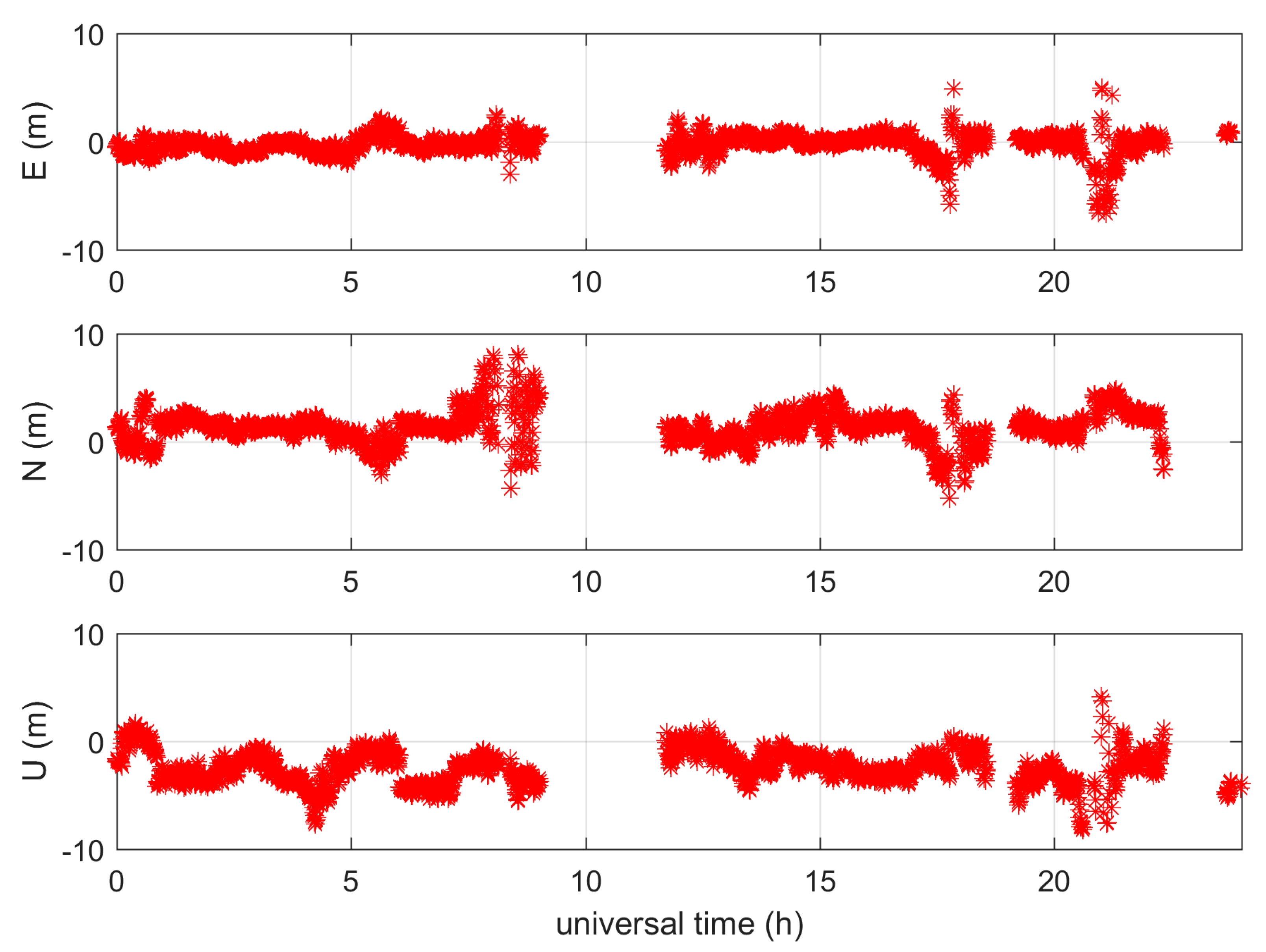


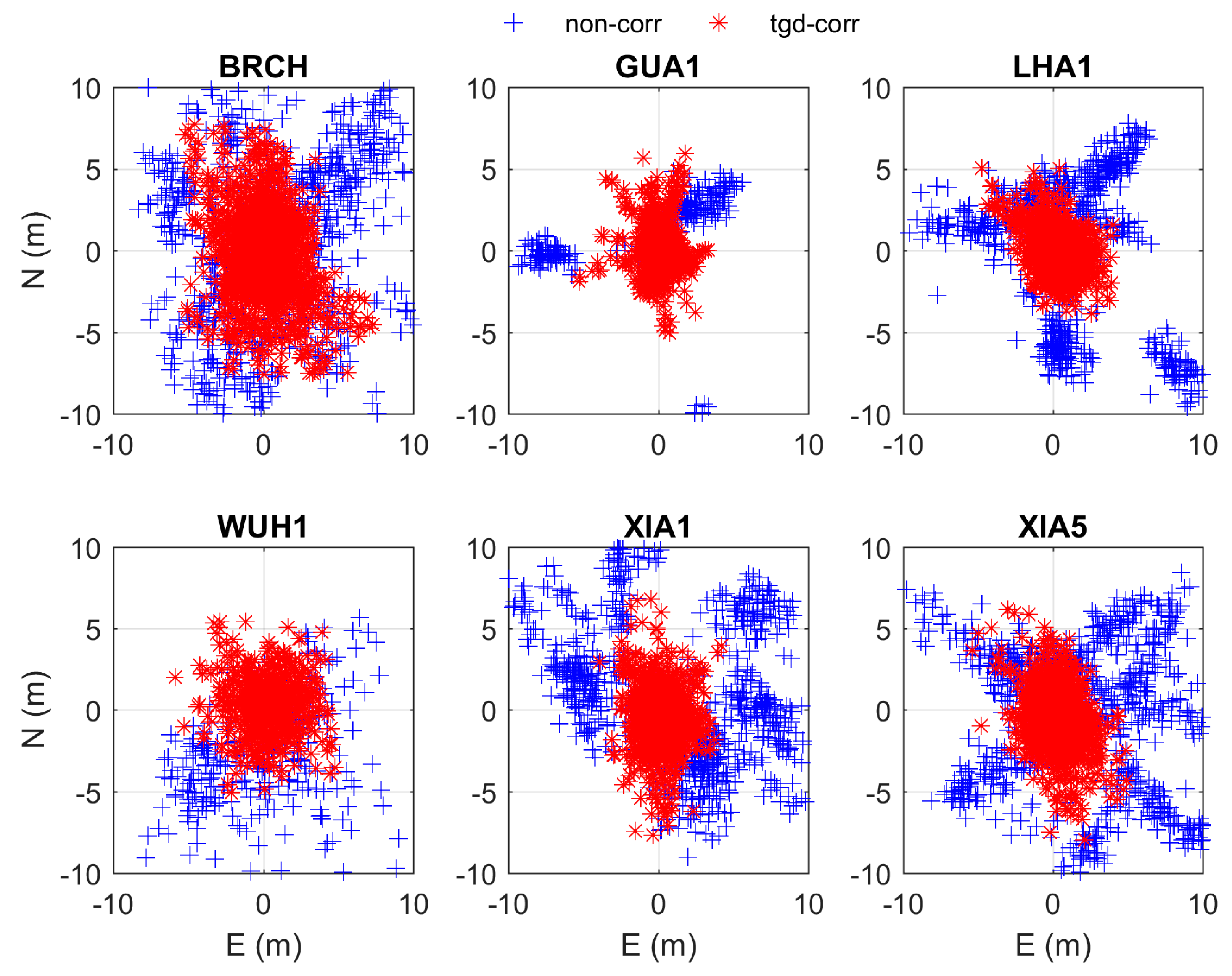


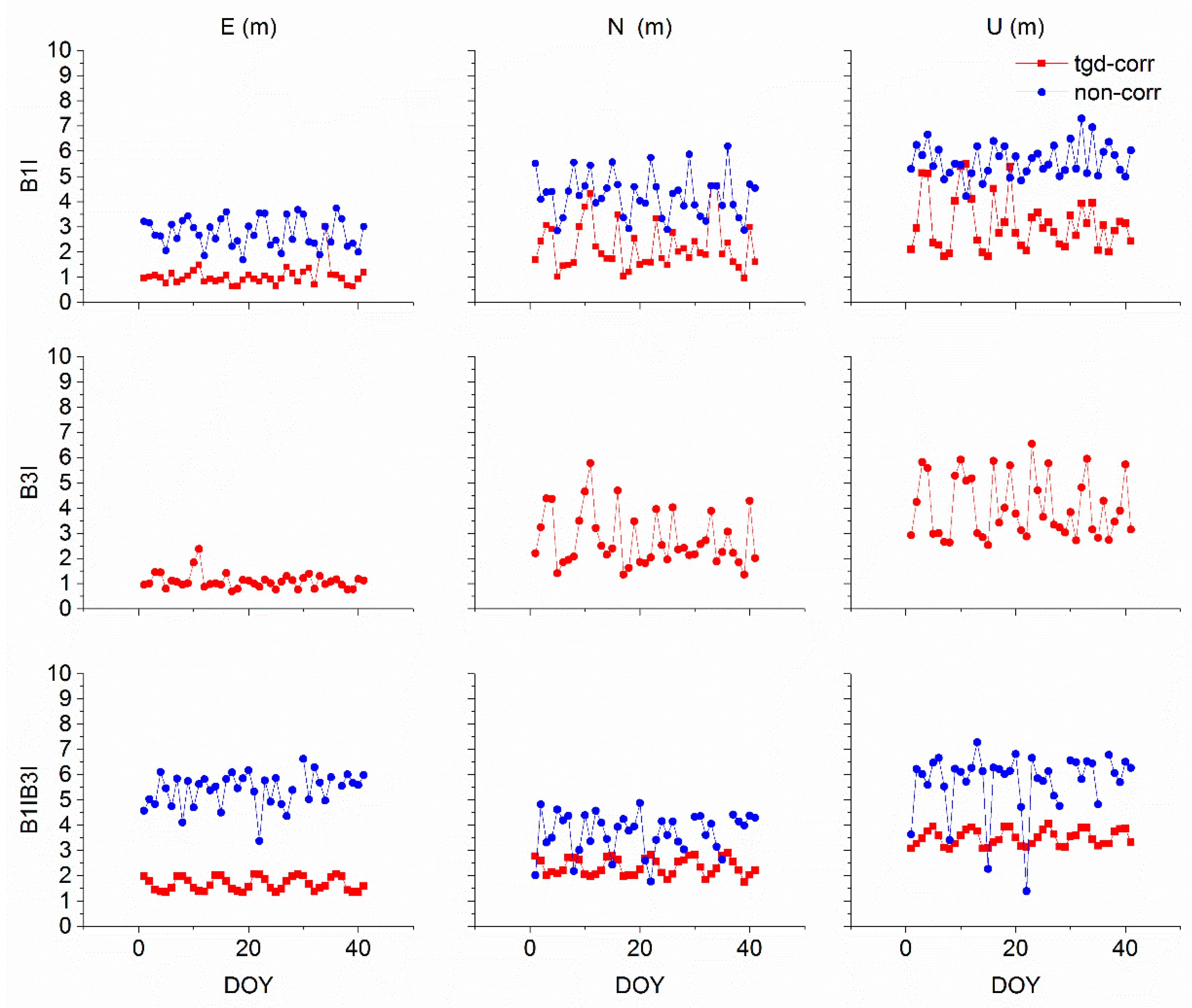



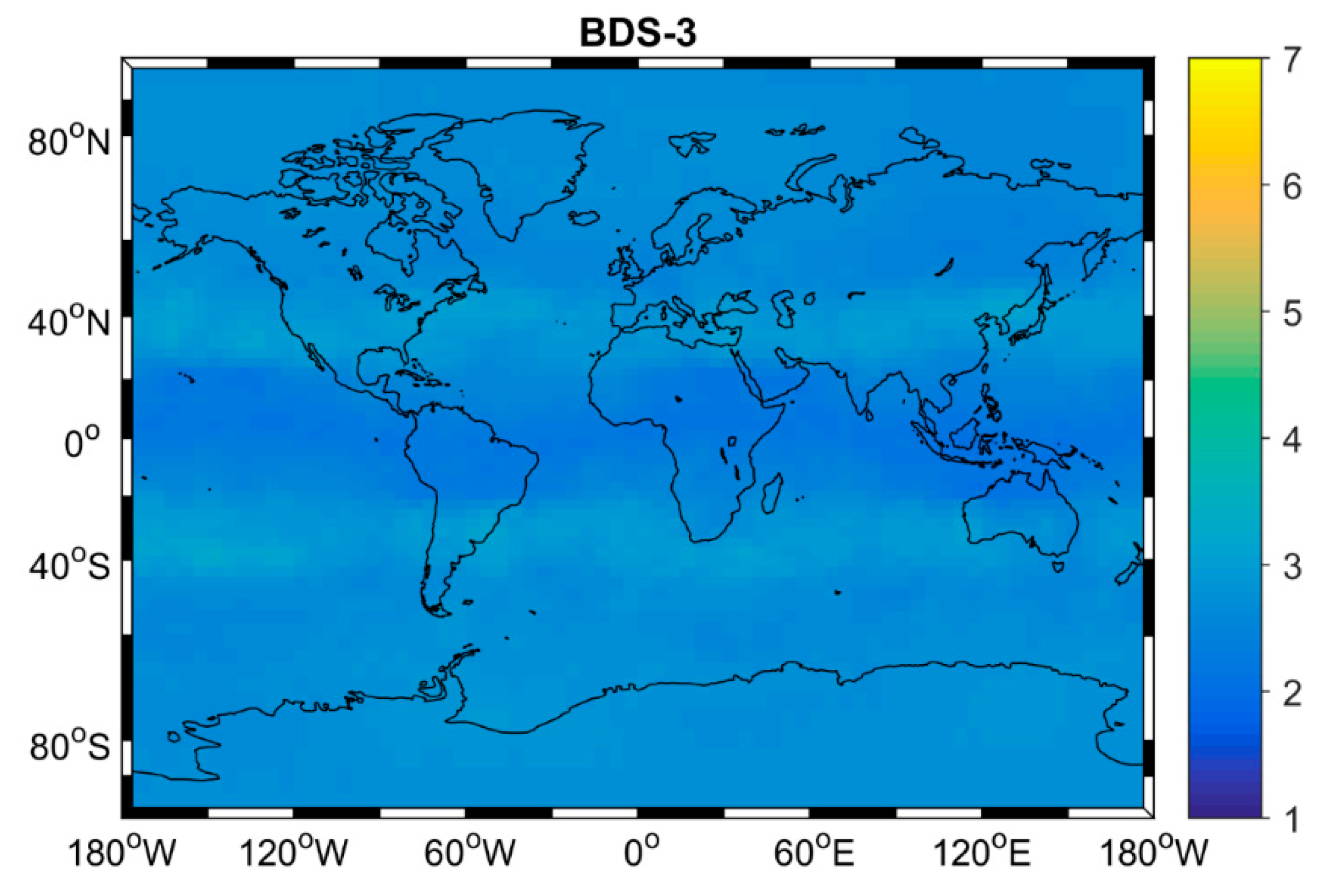
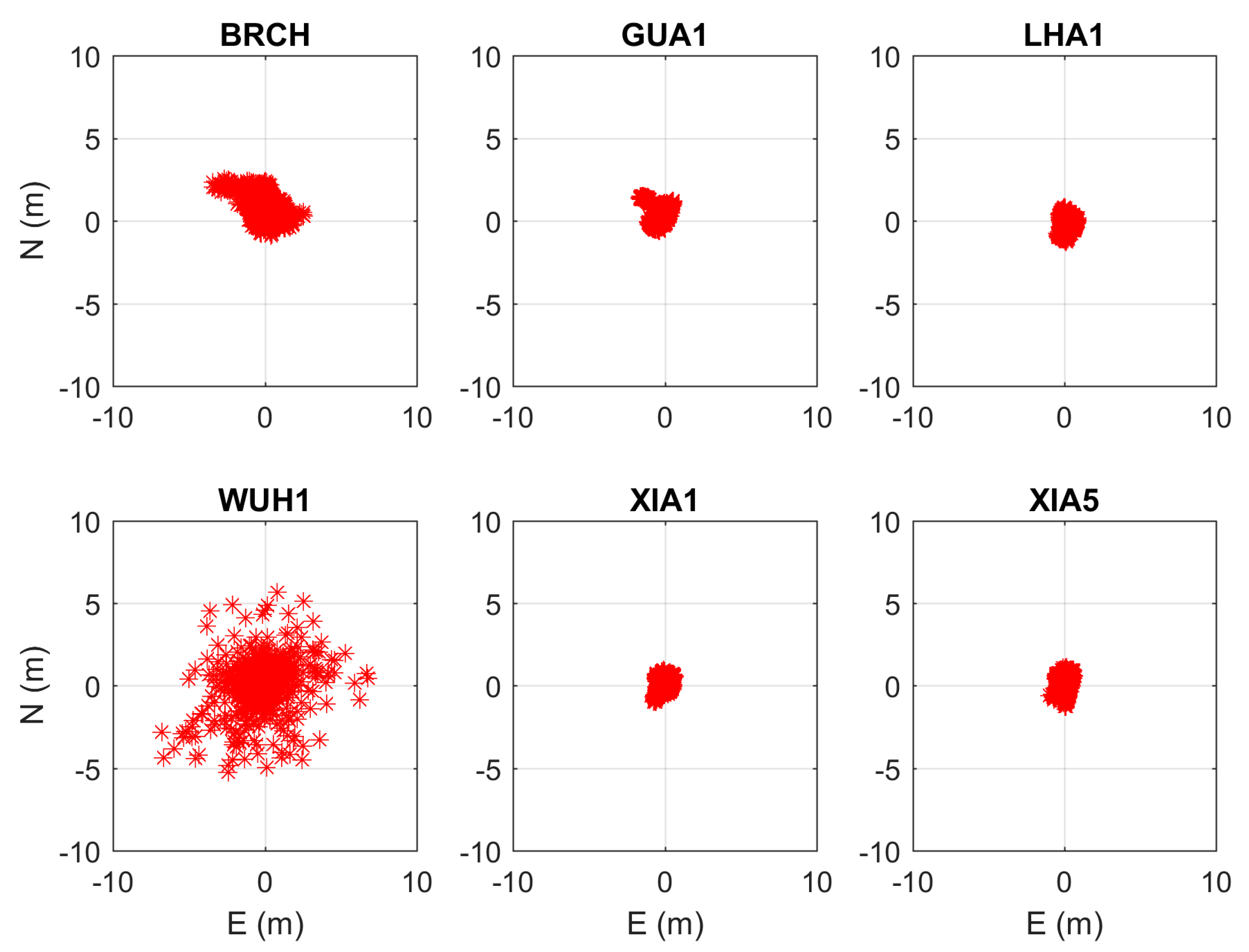

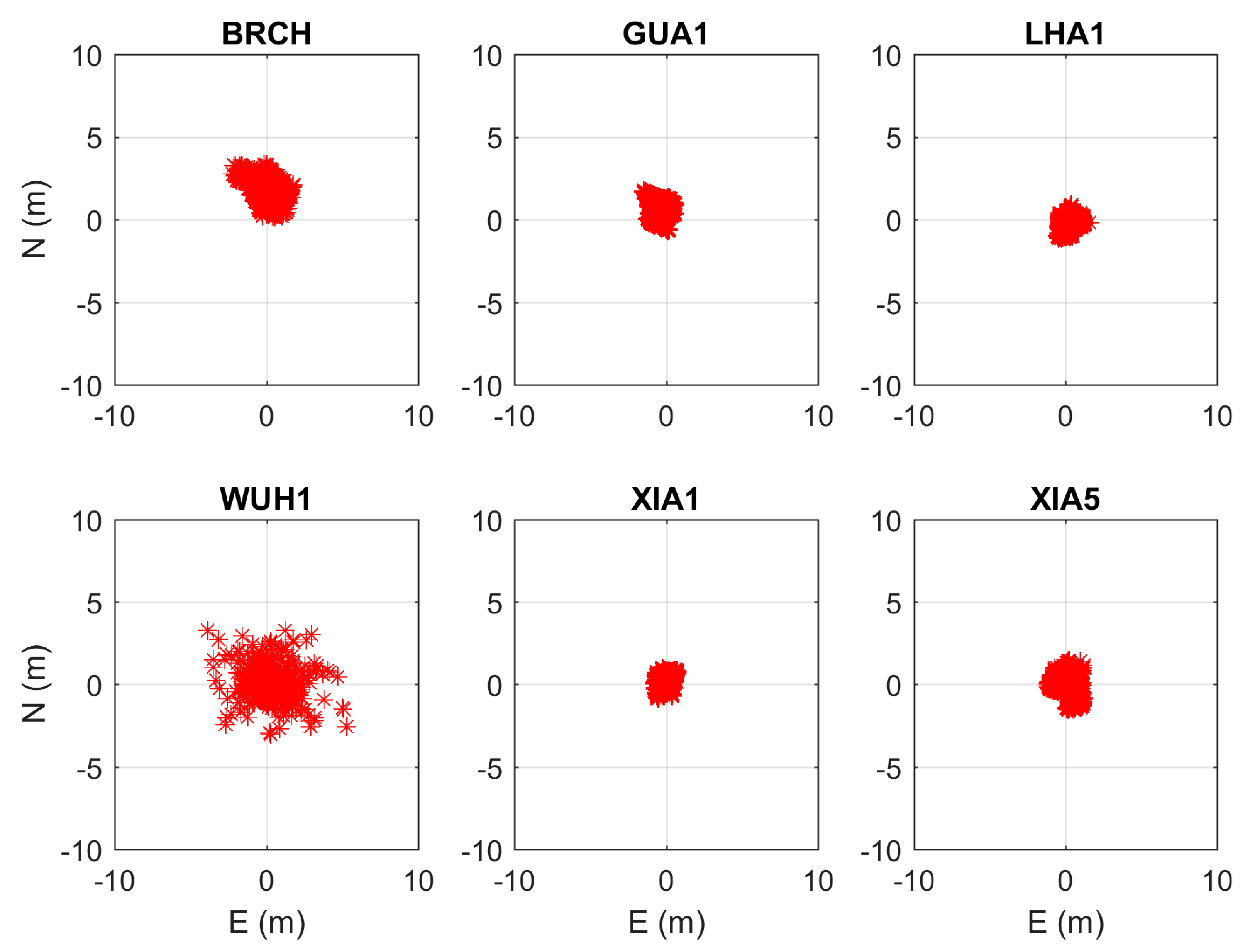


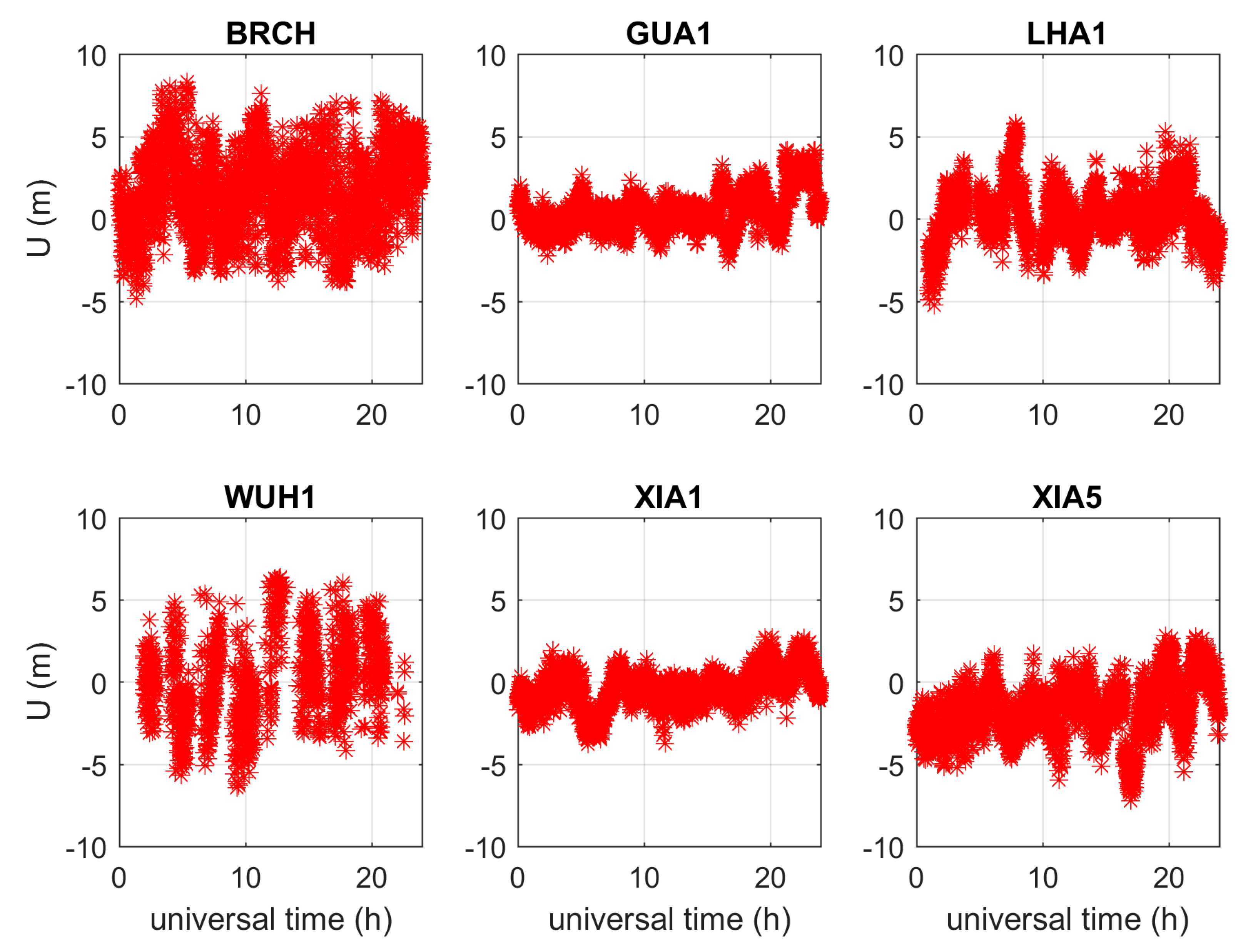

| Satellite | SVN | Int.sat.ID | NORAD.ID | Manuf. | PRN | Notes |
|---|---|---|---|---|---|---|
| MEO-2 | C202 | 2017-069B | 43002 | CAST | C20 | Slot B-8; launched 5 November 2017 |
| MEO-1 | C201 | 2017-069A | 43001 | CAST | C19 | SlotB-7; launched 5 November 2017 |
| MEO-7 | C203 | 2018-003A | 43107 | SECM | C27 | Slot A-4; launched 12 January 2018 |
| MEO-8 | C204 | 2018-003B | 43108 | SECM | C28 | Slot A-5; launched 12 January 2018 |
| MEO-4 | C205 | 2018-018A | 43207 | CAST | C22 | Slot B-6; launched 12 February 2018 |
| MEO-3 | C206 | 2018-018B | 43208 | CAST | C21 | Slot B-5; launched 12 February 2018 |
| MEO-9 | C207 | 2018-029A | 43245 | SECM | C29 | Slot A-2; launched 30 March 2018 |
| MEO-10 | C208 | 2018-029B | 43246 | SECM | C30 | Slot A-3; launched 30 March 2018 |
| MEO-5 | C209 | 2018-062A | 43581 | CAST | C23 | Slot C-7; launched 29 July 2018 |
| MEO-6 | C210 | 2018-062B | 43582 | CAST | C24 | Slot C-1; launched 29 July 2018 |
| MEO-11 | C211 | 2018-067A | 43602 | SECM | C26 | Slot C-2; launched 25 August 2018 |
| MEO-12 | C212 | 2018-067B | 43603 | SECM | C25 | Slot C-8; launched 25 August 2018 |
| MEO-13 | C213 | 2018-072A | 43622 | CAST | C32 | Slot B-1; launched 19 September 2018 |
| MEO-14 | C214 | 2018-072B | 43623 | CAST | C33 | Slot B-3; launched 19 September 2018 |
| MEO-16 | C215 | 2018-078A | 43647 | SECM | C35 | Slot A-1; launched 15 October 2018 |
| MEO-15 | C216 | 2018-078B | 43648 | SECM | C34 | Slot A-7; launched 15 October 2018 |
| GEO-1 | C217 | 2018-085A | 43683 | CAST | C59 | Launched 1 November 2018 |
| MEO-17 | C218 | 2018-093A | 43706 | CAST | C36 | Slot C-4; launched 19 November 2018 |
| MEO-18 | C219 | 2018-093B | 43707 | CAST | C37 | Slot C-6; launched 19 November 2018 |
| IGSO-1 | C220 | 2019-023B | 44204 | - | - | Launched 20 April 2019 |
| Signal | Signal Component | Carrier Frequency (MHz) | Modulation | Wavelength (cm) | Chip Rate (Mcps) |
|---|---|---|---|---|---|
| B1I | - | 1561.098 | BPSK (2) | 19.2 | 2.046 |
| B1C | B1C_data | 1575.420 | BOC | 19.03 | 1.023 |
| B1C_pilot | QMBOC | ||||
| B2a | B2a_data | 1176.450 | BPSK (10) | 25.48 | 10.23 |
| B2a_pilot | |||||
| B2b | - | 1207.140 | QPSK | 24.83 | 10.23 |
| B3I | - | 1268.520 | BPSK (10) | 23.63 | 10.23 |
| Model | System | Single-Frequency | Dual-Frequency | Schemes |
|---|---|---|---|---|
| SPP | BDS-2 | B1I, B3I | B1I/B3I | non-corr; tgd-corr |
| BDS-3 | B1I, B3I, B1C, B2a | B1I/B3I, B1C/B2a | ||
| BDS-2+BDS-3 | B1I, B3I | B1I/B3I |
| Station | Receiver | Antenna |
|---|---|---|
| BRCH | CETC-54-GMR-4016 | NOV750.R4 |
| GUA1 | GNSS-GGR | RINT-8CH |
| LHA1 | CETC-54 GMR-4011 | NOV750.R4 |
| WUH1 | CETC-54-GMR-4016 | LEIAR25.R4 |
| XIA1 | GNSS-GGR | RINT-8CH |
| XIA5 | CETC-54-GMR-4011 | TRM59900.00 |
| Scheme | B1I | B3I | B1I/B3I | |
|---|---|---|---|---|
| E | tgd-corr | 1.28 | - | 1.60 |
| non-corr | 2.69 | 1.27 | 5.36 | |
| Improvement (%) | 52.4 | - | 70.1 | |
| N | tgd-corr | 0.97 | - | 1.32 |
| non-corr | 2.30 | 1.12 | 5.12 | |
| Improvement (%) | 57.8 | - | 74.2 | |
| U | tgd-corr | 2.22 | - | 2.98 |
| non-corr | 4.08 | 2.75 | 5.67 | |
| Improvement (%) | 45.6 | - | 47.4 | |
| Scheme | B1I | B3I | B1C | B2a | B1I/B3I | B1C/B2a | |
|---|---|---|---|---|---|---|---|
| E | tgd-corr | 1.08 | - | 1.18 | 1.13 | 1.53 | 1.66 |
| non-corr | 3.38 | 1.15 | 3.35 | 2.84 | 6.13 | 4.89 | |
| Improvement (%) | 68.0 | - | 64.8 | 60.2 | 75.0 | 66.1 | |
| N | tgd-corr | 1.29 | - | 1.48 | 1.60 | 1.67 | 1.85 |
| non-corr | 4.19 | 1.57 | 4.16 | 3.59 | 5.76 | 4.88 | |
| Improvement (%) | 69.2 | - | 64.4 | 55.4 | 71.0 | 62.1 | |
| U | tgd-corr | 2.73 | - | 2.91 | 4.18 | 2.96 | 3.58 |
| non-corr | 5.37 | 3.54 | 5.96 | 5.09 | 5.42 | 6.31 | |
| Improvement (%) | 49.2 | - | 51.2 | 19.8 | 45.4 | 43.3 | |
| Scheme | B1I | B3I | B1I/B3I | |
|---|---|---|---|---|
| E | tgd-corr | 0.86 | - | 1.18 |
| non-corr | - | 0.90 | - | |
| N | tgd-corr | 0.85 | - | 1.08 |
| non-corr | - | 1.07 | - | |
| U | tgd-corr | 1.84 | - | 2.17 |
| non-corr | - | 2.56 | - | |
© 2019 by the authors. Licensee MDPI, Basel, Switzerland. This article is an open access article distributed under the terms and conditions of the Creative Commons Attribution (CC BY) license (http://creativecommons.org/licenses/by/4.0/).
Share and Cite
Dai, P.; Ge, Y.; Qin, W.; Yang, X. BDS-3 Time Group Delay and Its Effect on Standard Point Positioning. Remote Sens. 2019, 11, 1819. https://doi.org/10.3390/rs11151819
Dai P, Ge Y, Qin W, Yang X. BDS-3 Time Group Delay and Its Effect on Standard Point Positioning. Remote Sensing. 2019; 11(15):1819. https://doi.org/10.3390/rs11151819
Chicago/Turabian StyleDai, Peipei, Yulong Ge, Weijin Qin, and Xuhai Yang. 2019. "BDS-3 Time Group Delay and Its Effect on Standard Point Positioning" Remote Sensing 11, no. 15: 1819. https://doi.org/10.3390/rs11151819
APA StyleDai, P., Ge, Y., Qin, W., & Yang, X. (2019). BDS-3 Time Group Delay and Its Effect on Standard Point Positioning. Remote Sensing, 11(15), 1819. https://doi.org/10.3390/rs11151819





